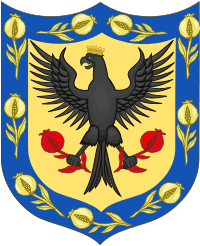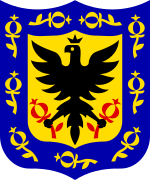Coat of arms of Bogotá facts for kids
Quick facts for kids Coat of arms of Bogotá (during Colonial times) |
|
|---|---|
 |
|
| Versions | |

Modern version in use
|
|
| Armiger | The Very Noble and Very Loyal City of Bogotá. |
| Adopted | December 3, 1548 |
| Blazon | Or, a bordure azure nine pomegranates in orle Or, an eagle displayed sable crowned Or holding in its talons pomegranates gules. |
| Use | Emblem and official documents. |
The official coat of arms of Bogotá, the capital city of Colombia, is a special symbol. It was first given to the city by Emperor Charles V on December 3, 1548. This happened in a city called Valladolid in Spain.
This coat of arms was used for a long time by the Viceroyalty of New Granada. This was a large area in South America controlled by Spain. After Colombia became independent, a new coat of arms was made for the new country.
Even though a new national symbol was created, Bogotá's original coat of arms was still used unofficially. Later, in 1932, it was officially adopted again as the symbol for the city of Bogotá. This was done through something called "Accord 31 of 1932."
Contents
Understanding the Bogotá Coat of Arms
The coat of arms of Bogotá has many interesting parts. Each part tells a story about the city's history and its connection to Spain. Let's look at what each symbol means.
The Imperial Eagle
In the very center of the shield, you'll see a large, powerful Imperial Eagle. This eagle is completely black, which in heraldry (the study of coats of arms) is called sable. The background behind the eagle is gold, known as or.
This eagle was a special gift from Emperor Charles V. It shows the strong link between Bogotá and the Spanish Empire. The eagle holds two red pomegranates in its claws. These pomegranates are a symbol of the "New Kingdom of Granada," which was the name for the Spanish lands in this part of South America. Red is called gules in heraldry.
The Border and Pomegranates
Around the main part of the shield, there is a border. This border is blue, which is called azure. On this blue border, there are nine golden pomegranates. These nine pomegranates represent the different regions that made up the "New Kingdom of Granada" at that time. They show how different areas came together under one symbol.
See also
 In Spanish: Escudo de Bogotá para niños
In Spanish: Escudo de Bogotá para niños

